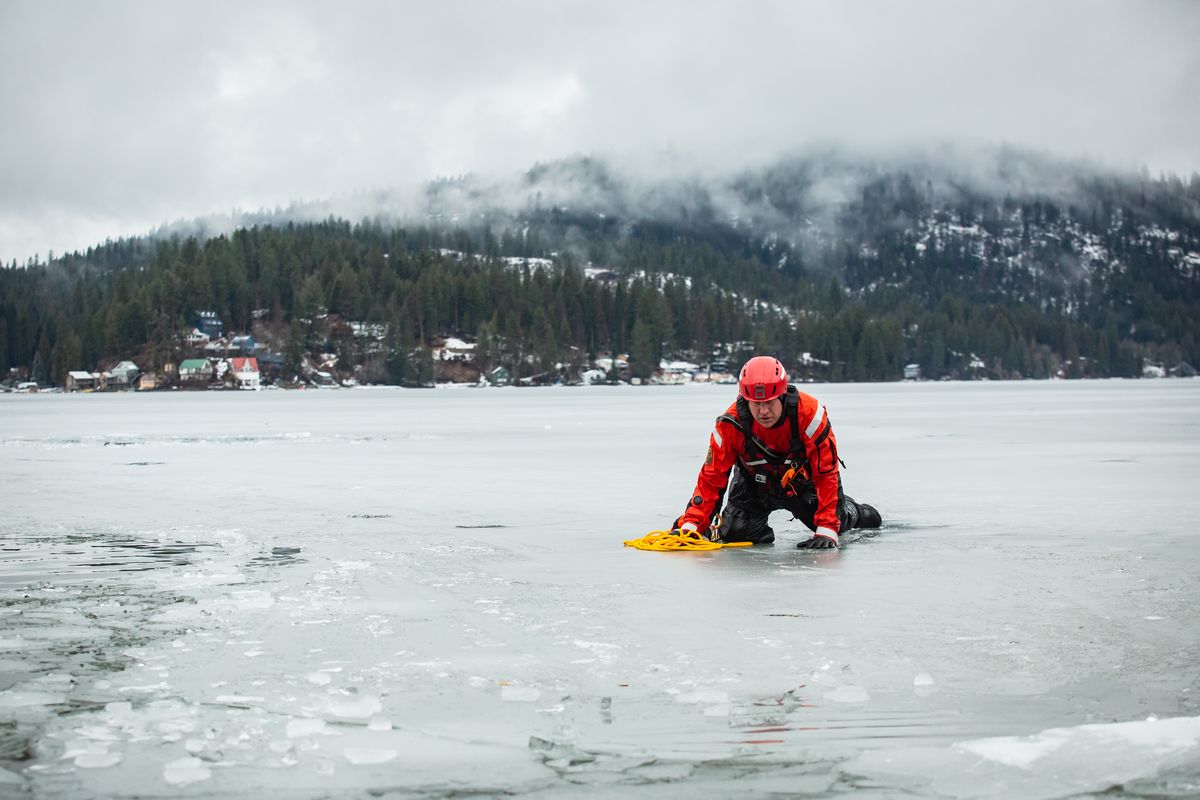SVFD navigates thin ice: Firefighters get feet wet in annual winter rescue training

The thin ice covering Newman Lake last week was weak, fragile and prone to collapsing under people’s feet – perfect for some ice rescue training for Spokane Valley Fire Department crews.
The idea was that each crew was to head out to a hole in the ice about 150 feet off shore, rescue a dummy under the ice, then move to another hole where they would take turns rescuing each other. But the reality was more difficult, as firefighters struggled to stay out of the water. Attempts at walking across the ice quickly turned to crawling on all fours or crawling on their stomachs in an attempt to distribute their weight across a larger area to avoid breaking through. It didn’t work well.

Capt. Karl Cantrell, who was trying to make his way to the offshore hole in the ice, struggled to advance as the ice repeatedly collapsed beneath him. He hadn’t even made it halfway when he flipped over on his back to catch his breath. “I’m exhausted,” he said.
While the flimsy ice made training more difficult, it also made it more realistic, said department spokesman Craig Warzon.
“This is perfect training ice because this is what people fall through, what animals fall through,” he said.
The department hasn’t responded to any ice rescue calls yet this winter, but they have happened, Warzon said. Typically, what happens is that a dog runs out on the ice and falls through and then the owner falls through while trying to rescue the dog. If a pet does head out onto thin ice, Warzon said people should call for help rather than going out on the flimsy ice themselves.
“If it won’t support your pet, it won’t support you,” he said. “Call us.”
Ice should be at least 4 inches thick to support a person, Warzon said. Six inches is needed to support an ATV or snowmobile and a solid 8 inches is needed for a larger vehicle. Good ice should be clear with few air bubbles. While the ice on Newman Lake was about 3 inches thick recently, snow and rain that fell on it thinned and weakened the ice.
Crews that are assigned to stations near Liberty Lake and Shelley Lake receive ice rescue training once a year, Warzon said. Firefighters must have had that training in the previous 18 months or they cannot perform an ice rescue.
The training began with classroom work, then moved to Newman Lake for hands-on training over three days last week. Firefighters wore special immersion suits that are designed for ice rescues and have insulation that provides some protection from the cold. But that thermal protection doesn’t last long in icy water, Warzon said, and it doesn’t protect against freezing water splashing on faces when firefighters broke through the ice.
The training was different this year because of the COVID-19 pandemic.
“We normally have a scenario,” he said. “When they show up, they do the rescue like it’s an actual call.”
The training groups were also smaller this year because of masking and social distancing requirements. Firefighters wore masks on shore, but had to remove them when they went into the water because a wet mask is impossible to breathe through, Warzon said. Care was taken to keep crews from different stations separate.
“Only crews that work in the same station rescue each other,” he said.
Each crew completed its assigned tasks, with plenty of opportunities for self-rescue along the way as firefighters pulled themselves out of the water each time they broke through the ice. Warzon, who was also one of the trainers, occasionally shouted advice across the fractured ice. Cold and dripping, firefighters emerged from the water one at a time, ready to rescue anyone who might need help over the next year.